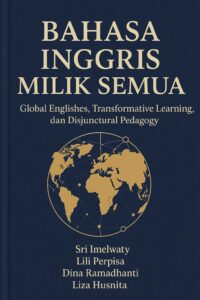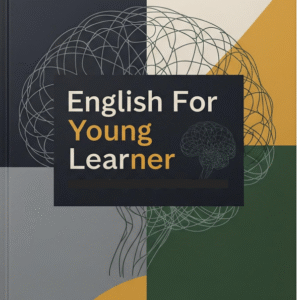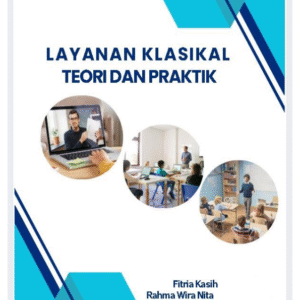| Daftar Pustaka |
Alderson, J. C., Clapham, C., & Wall, D. (1995). Language test construction and evaluation. Cambridge University Press.
Ammon, U. (2010). The dominance of English as a language of science: Effects on other languages and language communities. De Gruyter Mouton.
Bachman, L., & Palmer, A. (2010). Language assessment in practice. Oxford University Press.
Baker, W. (2015). Culture and identity through English as a lingua franca. De Gruyter Mouton.
Barkhuizen, G. (2017). Reflections on language teacher identity research. Routledge.
Bayyurt, Y., & Sifakis, N. C. (2015). Developing an ELF-aware pedagogy. In H. Bowles & A. Cogo (Eds.), International perspectives on English as a lingua franca (pp. 117–135). Palgrave Macmillan.
Bayyurt, Y., & Sifakis, N. C. (2018). ELF-aware teacher education. ELT Journal, 72(3), 273–284. https://doi.org/10.1093/elt/ccy012
Beauchamp, C., & Thomas, L. (2009). Understanding teacher identity. Cambridge Journal of Education, 39(2), 175–189. https://doi.org/10.1080/03057640902902252
Brown, H. D., & Lee, H. (2015). Teaching by principles (4th ed.). Pearson.
Brown, J. D., & Abeywickrama, P. (2018). Language assessment: Principles and classroom practices (3rd ed.). Pearson.
Canagarajah, A. S. (1999). Resisting linguistic imperialism in English teaching. Oxford University Press.
Canagarajah, A. S. (2013). Translingual practice: Global Englishes and cosmopolitan relations. Routledge.
Choi, J. (2016). English language assessment for ELF contexts. Language Assessment Quarterly, 13(4), 330–345. https://doi.org/10.1080/15434303.2016.1230120
Cogo, A. (2012). ELF and super-diversity: A case study of ELF multilingual practices. Journal of English as a Lingua Franca, 1(2), 287–313. https://doi.org/10.1515/jelf-2012-0014
Cranton, P. (2006). Understanding and promoting transformative learning (2nd ed.). Jossey-Bass.
Crystal, D. (2003). English as a global language (2nd ed.). Cambridge University Press.
Derwing, T. M., & Munro, M. J. (2005). Second language accent and pronunciation teaching. TESOL Quarterly, 39(3), 379–397. https://doi.org/10.2307/3588486
Derwing, T. M., & Munro, M. J. (2015). Pronunciation fundamentals: Evidence-based perspectives for L2 teaching and research. John Benjamins.
Elder, C. (2016). ELF and language assessment: Where are we now? In L. Harding & M. Ryan (Eds.), The Routledge handbook of language testing (pp. 180–193). Routledge.
Elder, C., & Harding, L. (2008). Language testing and English as a lingua franca. In J. Cummins & C. Davison (Eds.), The international handbook of English language teaching (pp. 255–270). Springer.
Fang, F. (2018). Reframing English education in China from a Global Englishes perspective. System, 73, 58–69. https://doi.org/10.1016/j.system.2017.11.006
Farrell, T. S. C. (2015). Promoting teacher reflection in second language education: A framework for TESOL professionals. Routledge.
Galloway, N., & Numajiri, T. (2020). Global Englishes language teaching: A systematic review. TESOL Quarterly, 54(4), 1189–1229. https://doi.org/10.1002/tesq.623
Galloway, N., & Rose, H. (2015). Introducing Global Englishes. Routledge.
García, O., & Wei, L. (2014). Translanguaging: Language, bilingualism and education. Palgrave Macmillan.
Gilmore, A. (2007). Authentic materials and authenticity in foreign language learning. Language Teaching, 40(2), 97–118. https://doi.org/10.1017/S0261444807004144
Graddol, D. (2006). English next. British Council.
Hafner, C. A., & Miller, L. (2011). Fostering learner autonomy through digital video production. Language Learning & Technology, 15(3), 70–86.
Harding, L. (2012). English as a lingua franca and language testing: The challenge of construct definition. Language Testing, 29(2), 227–244. https://doi.org/10.1177/0265532211421478
Hockly, N. (2019). Digital literacies in ELT. ELT Journal, 73(4), 405–415. https://doi.org/10.1093/elt/ccz043
Holliday, A. (2006). Native-speakerism. ELT Journal, 60(4), 385–387. https://doi.org/10.1093/elt/ccl030
House, J. (2012). English as a lingua franca and pragmatic competence. Journal of English as a Lingua Franca, 1(1), 173–196. https://doi.org/10.1515/jelf-2012-0011
Hsu, H.-Y. (2020). YouTube-mediated EFL learning: A review of recent research. Computer Assisted Language Learning, 33(4), 403–421. https://doi.org/10.1080/09588221.2019.1572368
Illeris, K. (2014). Transformative learning and identity. Routledge.
Isaacs, T., & Trofimovich, P. (2012). Deconstructing comprehensibility: Identifying the linguistic influences on listeners’ L2 comprehensibility ratings. Studies in Second Language Acquisition, 34(3), 475–505. https://doi.org/10.1017/S0272263112000150
Jandt, F. (2017). An introduction to intercultural communication (9th ed.). SAGE.
Jarvis, P. (2006). Towards a comprehensive theory of human learning. Routledge.
Jay, J. K., & Johnson, K. L. (2002). Capturing complexity: A typology of reflective practice. Teaching and Teacher Education, 18(1), 73–85. https://doi.org/10.1016/S0742-051X(01)00051-8
Jenkins, J. (2000). The phonology of English as an international language. Oxford University Press.
Jenkins, J. (2007). English as a lingua franca: Attitude and identity. Oxford University Press.
Jenkins, J. (2015). Global Englishes: A resource book for students (3rd ed.). Routledge.
Jenkins, J., Baker, W., & Dewey, M. (Eds.). (2018). The Routledge handbook of English as a lingua franca. Routledge.
Kachru, B. B. (1985). Standards, codification and sociolinguistic realism: The English language in the Outer Circle. In R. Quirk & H. G. Widdowson (Eds.), English in the world (pp. 11–30). Cambridge University Press.
Kirkpatrick, A. (2010). English as a lingua franca in ASEAN: A multilingual model. Hong Kong University Press.
Kirkpatrick, A. (2012). English as an ASEAN lingua franca. Journal of English as a Lingua Franca, 1(1), 121–139. https://doi.org/10.1515/jelf-2012-0007
Kirkpatrick, A., & Sussex, R. (Eds.). (2012). English as an international language in Asia: Implications for language education. Springer.
Knoch, U., & Low, E. L. (2020). Approaches to assessing English as a lingua franca. In E. Leung & B. Lewkowicz (Eds.), English language education in a global world (pp. 205–224). Springer.
Lauder, A. (2008). The status and function of English in Indonesia: A review of key factors. Makara, Sosial Humaniora, 12(1), 9–20. https://doi.org/10.7454/mssh.v12i1.128
Leung, C., & Lewkowicz, J. (2006). Expanding academic literacy? English for Specific Purposes, 25(4), 355–367. https://doi.org/10.1016/j.esp.2006.02.002
Levis, J. (2005). Changing contexts and shifting paradigms in pronunciation teaching. TESOL Quarterly, 39(3), 369–377. https://doi.org/10.2307/3588485
Levis, J. (2018). Intelligibility, oral communication, and the teaching of pronunciation. Cambridge University Press.
Li, W. (2018). Translanguaging as a practical theory of language. Applied Linguistics, 39(1), 9–30. https://doi.org/10.1093/applin/amx039
Lie, A. (2007). Education policy and EFL curriculum in Indonesia: Between the commitment to competence and the quest for higher test scores. TEFLIN Journal, 18(1), 1–14.
Low, E. L. (2022). English in Singapore: Looking back, looking forward. World Englishes, 41(1), 9–22. https://doi.org/10.1111/weng.12568
Mahboob, A. (2010). The NNEST lens: Nonnative English speakers in TESOL. TESOL.
Marlina, R. (2018). Teaching English as an international language: Implementing, reviewing, and re-envisioning. Routledge.
Marlina, R., & Giri, R. A. (Eds.). (2014). The pedagogy of English as an international language: Perspectives from scholars, teachers, and students. Springer.
McKay, S. L. (2002). Teaching English as an international language: Rethinking goals and approaches. Oxford University Press.
McKay, S. L., & Brown, J. D. (2016). Teaching and assessing EIL in local contexts around the world. Routledge.
Medgyes, P. (1992). Native or non-native: Who’s worth more? ELT Journal, 46(4), 340–349. https://doi.org/10.1093/elt/46.4.340
Mezirow, J. (1991). Transformative dimensions of adult learning. Jossey-Bass.
Mezirow, J., & Taylor, E. W. (Eds.). (2009). Transformative learning in practice. Jossey-Bass.
Munro, M. J., & Derwing, T. M. (1995). Foreign accent, comprehensibility, and intelligibility in L2 speech. Language Learning, 45(1), 73–97. https://doi.org/10.1111/j.1467-1770.1995.tb00963.x
Nguyen, T. M. H. (2017). Intercultural communicative competence in ELF contexts. Language and Intercultural Communication, 17(3), 258–273. https://doi.org/10.1080/14708477.2016.1231621
Norton, B. (2013). Identity and language learning: Extending the conversation (2nd ed.). Multilingual Matters.
O’Hagan, M., & Zhang, Q. (2019). Crowdsourcing and online video subtitling in language learning. Translation and Translanguaging in Multilingual Contexts, 5(1), 60–86. https://doi.org/10.1075/ttmc.00024.oha
Pennycook, A. (2007). Global Englishes and transcultural flows. Routledge.
Pennycook, A. (2010). Language as a local practice. Routledge.
Phillipson, R. (1992). Linguistic imperialism. Oxford University Press.
Pitzl, M.-L. (2018). Transient international groups and ELF. De Gruyter Mouton.
Renandya, W. A., & Widodo, H. P. (Eds.). (2016). English language teaching today: Linking theory and practice. Springer.
Renandya, W. A., & Widodo, H. P. (2019). English language education in Southeast Asia: Problems and possibilities. RELC Journal, 50(2), 145–156. https://doi.org/10.1177/0033688219832138
Richards, J. C. (2015). Key issues in language teaching. Cambridge University Press.
Richards, J. C., & Farrell, T. S. C. (2011). Practice teaching: A reflective approach. Cambridge University Press.
Rose, H., & Galloway, N. (2019). Global Englishes for language teaching. Cambridge University Press.
Rose, H., McKinley, J., & Galloway, N. (2021). Global Englishes and language teaching: A review of pedagogical research. ELT Journal, 75(1), 1–14. https://doi.org/10.1093/elt/ccaa061
Saraceni, M. (2010). The relocation of English. Palgrave Macmillan.
Seargeant, P. (2012). Exploring World Englishes: Language in a global context. Routledge.
Seidlhofer, B. (2004). Research perspectives on teaching English as a lingua franca. Annual Review of Applied Linguistics, 24, 209–239. https://doi.org/10.1017/S0267190504000145
Seidlhofer, B. (2011). Understanding English as a lingua franca. Oxford University Press.
Sharifian, F. (Ed.). (2009). English as an international language: Perspectives and pedagogical issues. Multilingual Matters.
Sharifian, F. (2017). Cultural linguistics and EIL. Journal of English as an International Language, 12(2), 1–26.
Sifakis, N. C. (2014). ELF awareness in English language teaching. TESOL Quarterly, 48(2), 318–337. https://doi.org/10.1002/tesq.120
Sifakis, N. C., & Tsantila, N. (Eds.). (2019). English as a lingua franca for EFL contexts. Multilingual Matters.
Song, J., & Lin, A. M. Y. (2020). Translingual practices in English language teaching. ELT Journal, 74(4), 427–436. https://doi.org/10.1093/elt/ccaa027
Sukyadi, D., & Mardiani, R. (2011). The washback effect of English national examination on Indonesian teachers’ classroom teaching. K@ta, 13(1), 96–111.
Sung, C. C. M. (2018). Global Englishes and student attitudes: A longitudinal study. System, 73, 38–49. https://doi.org/10.1016/j.system.2017.11.005
Sung, C. C. M. (2020). Investments and identities in GE-informed pedagogy. RELC Journal, 51(3), 317–331. https://doi.org/10.1177/0033688219895347
Taylor, E. W. (2007). An update of transformative learning theory. International Journal of Lifelong Education, 26(2), 173–191. https://doi.org/10.1080/02601370701219475
Taylor, L. (2006). The changing landscape of English: Implications for language assessment. ELT Journal, 60(1), 51–60. https://doi.org/10.1093/elt/cci080
Trent, J. (2015). Identity construction and positioning in teacher education. Teaching and Teacher Education, 49, 56–65. https://doi.org/10.1016/j.tate.2015.02.006
Tripp, D. (1993). Critical incidents in teaching: Developing professional judgement. Routledge.
Varghese, M., Morgan, B., Johnston, B., & Johnson, K. A. (2005). Theorizing language teacher identity: Three perspectives and beyond. Journal of Language, Identity, and Education, 4(1), 21–44. https://doi.org/10.1207/s15327701jlie0401_2
Wenger, E. (1998). Communities of practice: Learning, meaning, and identity. Cambridge University Press.
Widdowson, H. G. (1994). The ownership of English. TESOL Quarterly, 28(2), 377–389. https://doi.org/10.2307/3587438
Widdowson, H. G. (2015). ELF and the inconvenience of established concepts. In N. Galloway & H. Rose (Eds.), Introducing Global Englishes (pp. 180–198). Routledge.
Widodo, H. P. (2015). The development of vocational English materials through critical needs analysis. In W. A. Renandya & H. P. Widodo (Eds.), English language teaching today: Linking theory and practice (pp. 127–146). Springer. https://doi.org/10.1007/978-3-319-22927-0_9
Widodo, H. P. (2016). Language policy in practice: Reframing the English language curriculum in Indonesia. In R. Kirkpatrick (Ed.), English language education policy in Asia (pp. 127–151). Springer. https://doi.org/10.1007/978-3-319-22464-0_7
Widodo, H. P. (2018). A critical micro-semiotic analysis of values depicted in the Indonesian Ministry of Education and Culture-endorsed secondary school English textbook. In X. Gao (Ed.), Second handbook of English language teaching (pp. 1–26). Springer. https://doi.org/10.1007/978-3-319-58542-0_34-1
Widodo, H. P. (2019). A critical reading of policy enactment and implementation in English language teaching in Indonesia. Journal of Asia TEFL, 16(2), 606–613. https://doi.org/10.18823/asiatefl.2019.16.2.23.606
Widodo, H. P., Fang, F., & Elyas, T. (2020). Theorizing English as a lingua franca in Asia: English language education implications. Asian Englishes, 22(1), 1–16. https://doi.org/10.1080/13488678.2019.1669303
Widodo, H. P., Perfecto, M. R., Van Canh, L., & Buripakdi, A. (Eds.). (2020). Situating moral and cultural values in ELT materials: The Southeast Asian context. Springer. https://doi.org/10.1007/978-3-030-55188-0
Yano, Y. (2009). The future of Englishes in Asia. In K. Murata & J. Jenkins (Eds.), Global Englishes in Asian contexts (pp. 208–224). Palgrave Macmillan.
Yuwono, G. I., & Harbon, L. (2010). English teacher professionalism and identity in Indonesia. Asian EFL Journal, 12(2), 144–158.
Zacharias, N. T. (2014). Teachers’ beliefs about EIL in Indonesia. Indonesian Journal of Applied Linguistics, 4(1), 27–38. https://doi.org/10.17509/ijal.v4i1.603
Zein, S. (2016). Professional development needs of primary EFL teachers in Indonesia. Professional Development in Education, 42(3), 405–424. https://doi.org/10.1080/19415257.2014.1001311
Zein, S. (2017). Language teacher education for early childhood English education in Asia. Routledge.
Zein, S. (2018). English language teacher education in Indonesia: Policy, research and practice. Routledge.
Zein, S., & Stroupe, R. (Eds.). (2020). English language teacher preparation in Asia: Policy, research and practice. Routledge.
Zein, S., & Garton, S. (2021). Early language learning policy in Asia and the Pacific. In S. Zein & S. Garton (Eds.), Early language learning policy in the 21st century: An international perspective (pp. 1–18). Springer. https://doi.org/10.1007/978-3-030-56618-1_1
|








Reviews
There are no reviews yet.